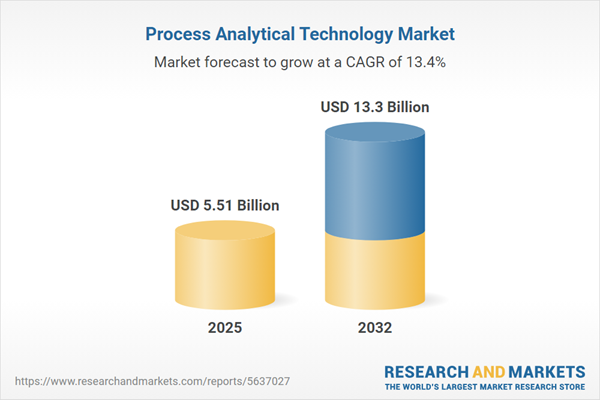Speak directly to the analyst to clarify any post sales queries you may have.
Process analytical technology is redefining quality assurance for manufacturing leaders across life sciences, industrial, and food sectors, driving next-generation process efficiency and real-time compliance. Senior decision-makers evaluating innovation strategies will find this report essential for aligning technology investments to evolving regulatory, operational, and supply chain imperatives.
Market Snapshot: Process Analytical Technology Market
The Process Analytical Technology Market grew from USD 4.87 billion in 2024 to USD 5.51 billion in 2025. It is set to expand at a CAGR of 13.35%, reaching USD 13.30 billion by 2032. The primary keyword "process analytical technology" features in the first segment, emphasizing both high adoption rates and robust demand across core end-user industries. Growth is driven by regulatory shifts, the pressing need for real-time monitoring, and rising investments in continuous manufacturing systems and digital process optimization.
Scope & Segmentation
- Measurement Technology: Calorimetry, gas chromatography, high-performance liquid chromatography, ion chromatography, gas chromatography-mass spectrometry, liquid chromatography-mass spectrometry, fluorescence spectroscopy, near-infrared spectroscopy, Raman spectroscopy, and ultraviolet-visible spectroscopy.
- Deployment Mode: At line, in line, off line, on line.
- Service Type: Calibration, installation and integration, maintenance and support.
- Application: Process control, quality control, real-time release testing.
- End User Industry: Biotechnology, chemicals, food and beverage, oil and gas, pharmaceuticals.
- Regional Coverage: Americas (North America, Latin America), Europe, Middle East & Africa (Europe, Middle East, Africa), Asia-Pacific.
- Key Companies: ABB Ltd, Emerson Electric Co., Endress+Hauser AG, Siemens AG, Thermo Fisher Scientific Inc., Agilent Technologies Inc., Mettler-Toledo International Inc., Yokogawa Electric Corporation, Honeywell International Inc., Schneider Electric SE.
Key Takeaways for Senior Decision-Makers
- Integrating advanced instrumentation into production lines enables real-time process control and builds a foundation for proactive quality management.
- Adoption of inline and online measurement technologies secures a competitive edge by streamlining product release and aligning with global regulatory frameworks.
- Emergence of machine learning and digital analytics platforms is accelerating the transition from reactive testing to predictive quality management in manufacturing execution systems.
- Miniaturized, portable inline analytical devices are delivering actionable insights, supporting both operational flexibility and sustainable process optimization.
- Market leaders are advancing through modular analytical platforms and strategic alliances, ensuring robust instrument support, compliance, and lifecycle cost management.
- Service-based differentiation, including remote support and continuous personnel training, underpins resilient adoption and maximizes instrument uptime.
Tariff Impact: Navigating 2025 U.S. Tariff Challenges
Recent United States tariffs on imported analytical technology components have introduced procurement complexity, raising acquisition costs and extending lead times. Many manufacturers are revisiting their supply chain strategies, with a shift toward local sourcing and modular solutions that allow for on-site maintenance and inventory control. Strategic partnerships with domestic vendors and service providers are now critical for maintaining routine calibration and uninterrupted production.
Methodology & Data Sources
This analysis relied on a multi-tiered approach, combining secondary research from peer-reviewed literature and regulatory documents with primary interviews and surveys targeting engineers and senior quality professionals. Data triangulation and patent landscape reviews ensured a rigorous, unbiased examination of market and technology trends.
Why This Report Matters
- Gives decision-makers clarity on fast-evolving process analytical technology trends and competitive moves across global markets.
- Highlights actionable opportunities to optimize operational efficiency and quality control in line with regulatory expectations.
- Supports supply chain resilience planning by uncovering vendor dynamics and responses to tariff and policy shifts.
Conclusion
This report provides a comprehensive view of process analytical technology’s strategic importance for manufacturing transformation. Senior executives can leverage these insights to make informed investments, ensure compliance, and achieve operational differentiation in a rapidly advancing market.
Additional Product Information:
- Purchase of this report includes 1 year online access with quarterly updates.
- This report can be updated on request. Please contact our Customer Experience team using the Ask a Question widget on our website.
Table of Contents
3. Executive Summary
4. Market Overview
7. Cumulative Impact of Artificial Intelligence 2025
Companies Mentioned
The companies profiled in this Process Analytical Technology market report include:- ABB Ltd
- Emerson Electric Co.
- Endress+Hauser AG
- Siemens AG
- Thermo Fisher Scientific Inc.
- Agilent Technologies Inc.
- Mettler-Toledo International Inc.
- Yokogawa Electric Corporation
- Honeywell International Inc.
- Schneider Electric SE
Table Information
| Report Attribute | Details |
|---|---|
| No. of Pages | 191 |
| Published | November 2025 |
| Forecast Period | 2025 - 2032 |
| Estimated Market Value ( USD | $ 5.51 Billion |
| Forecasted Market Value ( USD | $ 13.3 Billion |
| Compound Annual Growth Rate | 13.3% |
| Regions Covered | Global |
| No. of Companies Mentioned | 11 |









